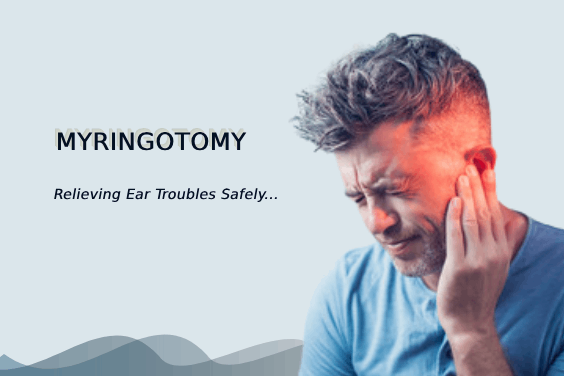Myringotomy is a surgical procedure aimed at relieving the eardrum from the presence of pus, sticky glue-like substances, or accumulated fluids. In certain cases, tiny tubes known as ‘Grommets’ are delicately inserted into the eardrum to facilitate optimal ventilation of the middle ear. Occasionally, slender tubes known as ‘Grommets’ are introduced into the eardrum to facilitate ventilation of the middle ear. Myringotomy stands as a widely practiced procedure for managing a range of middle ear conditions, encompassing middle ear infections, chronic fluid retention, and barotrauma. During this surgical maneuver, a small incision is meticulously crafted within the eardrum, permitting the orderly drainage of any accumulated fluids. To aid in the drainage process and stave off future fluid build-up, a diminutive conduit, often referred to as a tympanostomy tube or grommet, may be thoughtfully positioned within the incision. Myringotomy, whether conducted under local or general anesthesia, typically upholds its reputation as a secure and efficacious procedure. Nonetheless, akin to all medical interventions, it is not devoid of inherent risks, including potential bleeding, infections, or scarring of the eardrum. Thus, it remains imperative to engage in a candid discussion with your healthcare provider, weighing the advantages and potential pitfalls of this procedure, to ascertain its appropriateness for you or your child.
In instances of recurrent issues, a T-Tube may be substituted for a Grommet. A T-Tube boasts an indeterminate residence within the ear and typically necessitates surgical removal once its services are no longer required.
Following a myringotomy, meticulous post-care instructions come into play. It becomes crucial to maintain the ear’s cleanliness and dryness for several weeks post-surgery, thereby averting the onset of infections. You may receive a prescription for antibiotic ear drops and pain relief medication from your healthcare provider. Additionally, counsel may be dispensed to refrain from activities such as swimming, diving, or air travel until the ear attains complete convalescence. It is imperative to exercise caution when blowing your nose, refraining from forceful actions, and employing saline nasal sprays to keep the nasal passages adequately hydrated. In the event of excruciating pain, the onset of fever, or signs of infection, do not hesitate to promptly contact your healthcare professional. Adherence to these comprehensive post-operative guidelines serves as an essential facet of promoting the sound healing of the ear and mitigating potential complications.

